University of Manchester Smartphone Industry Analysis Report
VerifiedAdded on 2022/09/15
|17
|3870
|19
Report
AI Summary
This report offers a comprehensive analysis of the smartphone industry, examining how technological innovations drive corporate growth strategies. It begins with an overview of the industry, highlighting the significance of adopting new technologies to remain competitive. The report then explores the relationship between research and development (R&D) investment and profitability, investigating why some firms excel at embracing technological changes while others struggle. It delves into the impact of technological innovations on production efficiency and product development, emphasizing the importance of adapting to advancements. The analysis further addresses the challenges of aligning R&D investment with profit generation, considering factors like long-term perspectives and market dynamics. The report concludes by assessing the future of technological advancement and its influence on both the smartphone industry and individual firms, emphasizing the crucial role of innovation in ensuring sustainable growth within this dynamic sector.

Running head: AN ANALYSIS OF THE SMARTPHONE INDUSTRY
An Analysis of the Smartphone Industry
Name of Student:
Name of University:
Author Note:
An Analysis of the Smartphone Industry
Name of Student:
Name of University:
Author Note:
Paraphrase This Document
Need a fresh take? Get an instant paraphrase of this document with our AI Paraphraser
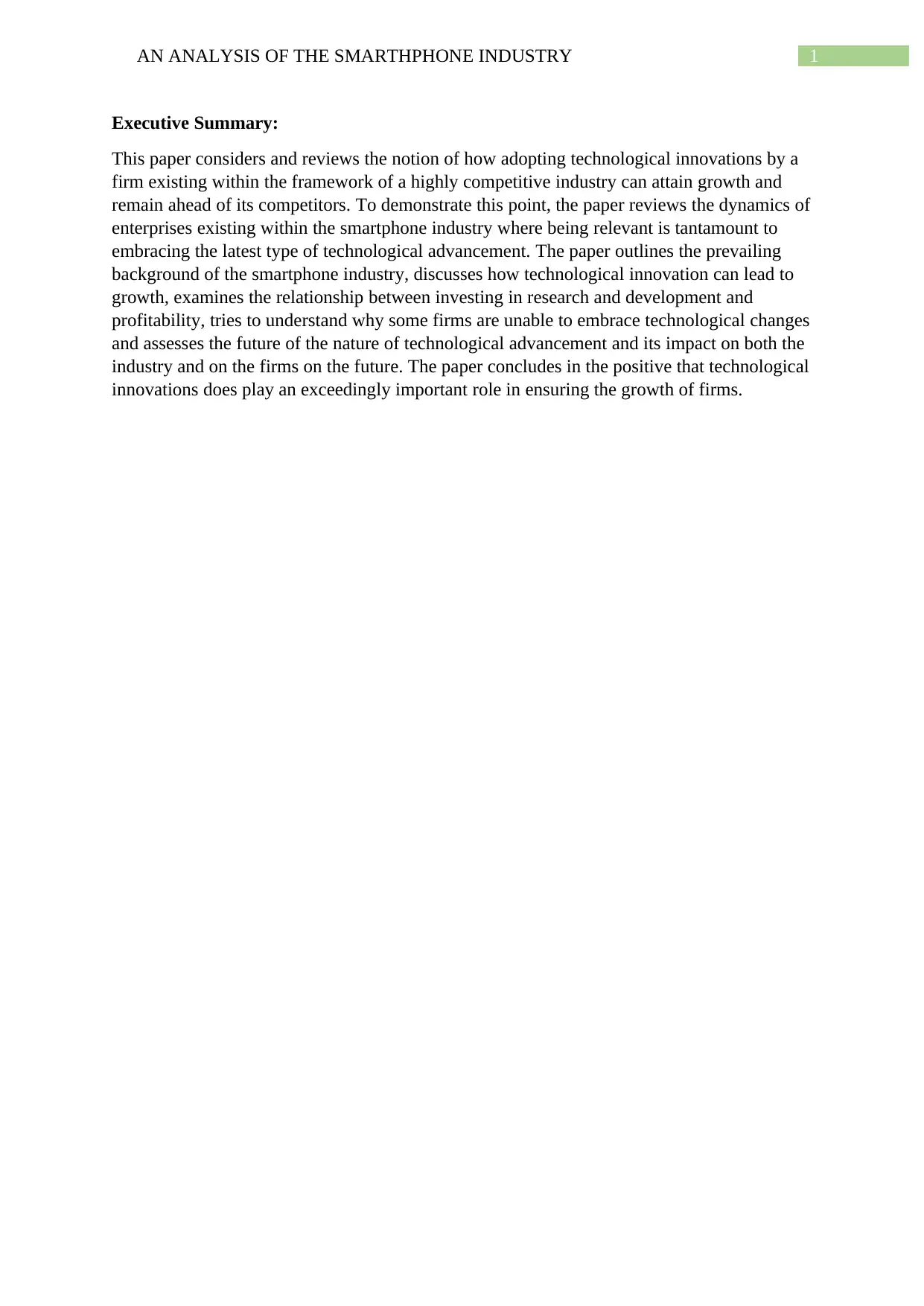
1AN ANALYSIS OF THE SMARTHPHONE INDUSTRY
Executive Summary:
This paper considers and reviews the notion of how adopting technological innovations by a
firm existing within the framework of a highly competitive industry can attain growth and
remain ahead of its competitors. To demonstrate this point, the paper reviews the dynamics of
enterprises existing within the smartphone industry where being relevant is tantamount to
embracing the latest type of technological advancement. The paper outlines the prevailing
background of the smartphone industry, discusses how technological innovation can lead to
growth, examines the relationship between investing in research and development and
profitability, tries to understand why some firms are unable to embrace technological changes
and assesses the future of the nature of technological advancement and its impact on both the
industry and on the firms on the future. The paper concludes in the positive that technological
innovations does play an exceedingly important role in ensuring the growth of firms.
Executive Summary:
This paper considers and reviews the notion of how adopting technological innovations by a
firm existing within the framework of a highly competitive industry can attain growth and
remain ahead of its competitors. To demonstrate this point, the paper reviews the dynamics of
enterprises existing within the smartphone industry where being relevant is tantamount to
embracing the latest type of technological advancement. The paper outlines the prevailing
background of the smartphone industry, discusses how technological innovation can lead to
growth, examines the relationship between investing in research and development and
profitability, tries to understand why some firms are unable to embrace technological changes
and assesses the future of the nature of technological advancement and its impact on both the
industry and on the firms on the future. The paper concludes in the positive that technological
innovations does play an exceedingly important role in ensuring the growth of firms.
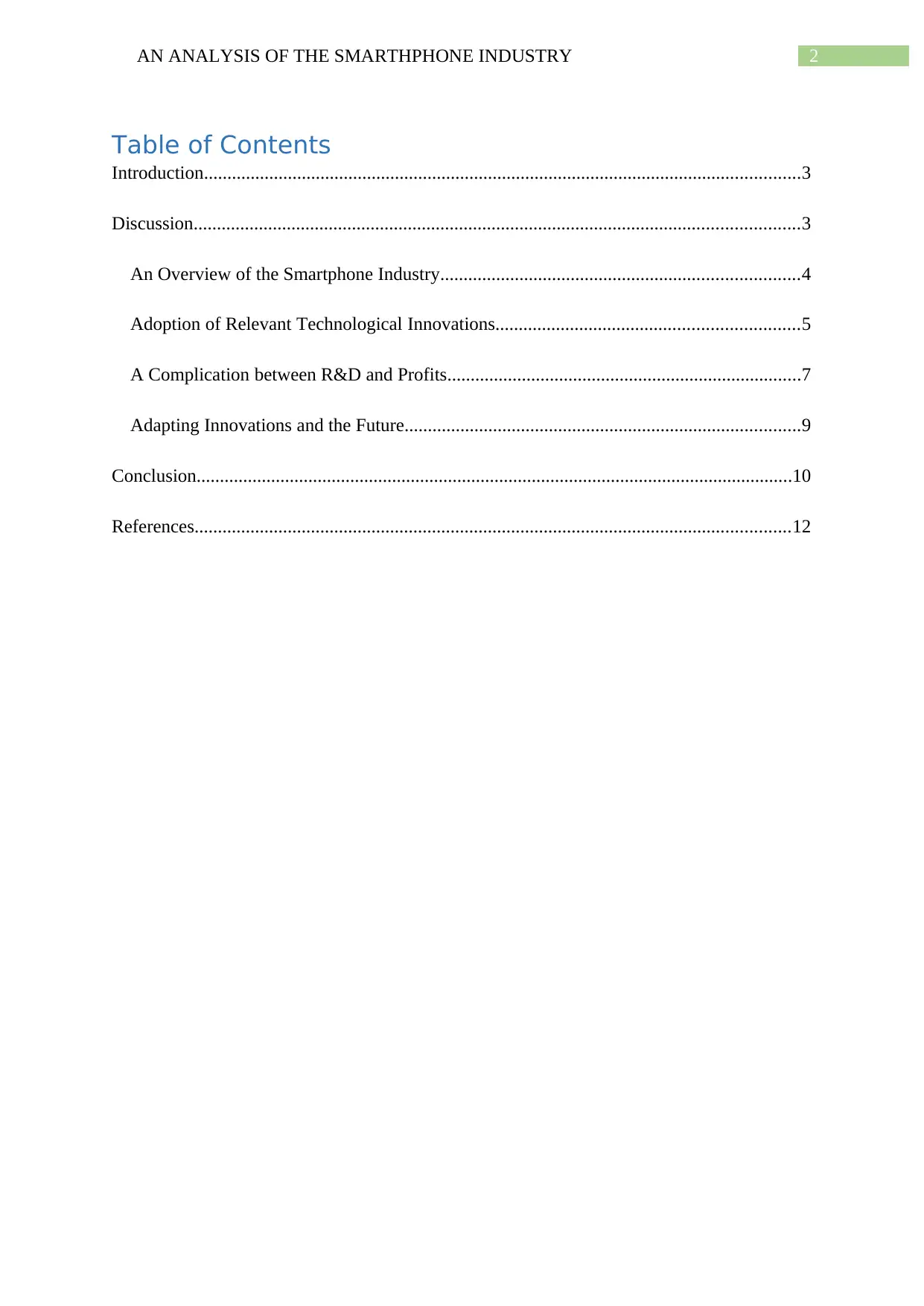
2AN ANALYSIS OF THE SMARTHPHONE INDUSTRY
Table of Contents
Introduction................................................................................................................................3
Discussion..................................................................................................................................3
An Overview of the Smartphone Industry.............................................................................4
Adoption of Relevant Technological Innovations.................................................................5
A Complication between R&D and Profits............................................................................7
Adapting Innovations and the Future.....................................................................................9
Conclusion................................................................................................................................10
References................................................................................................................................12
Table of Contents
Introduction................................................................................................................................3
Discussion..................................................................................................................................3
An Overview of the Smartphone Industry.............................................................................4
Adoption of Relevant Technological Innovations.................................................................5
A Complication between R&D and Profits............................................................................7
Adapting Innovations and the Future.....................................................................................9
Conclusion................................................................................................................................10
References................................................................................................................................12
⊘ This is a preview!⊘
Do you want full access?
Subscribe today to unlock all pages.

Trusted by 1+ million students worldwide
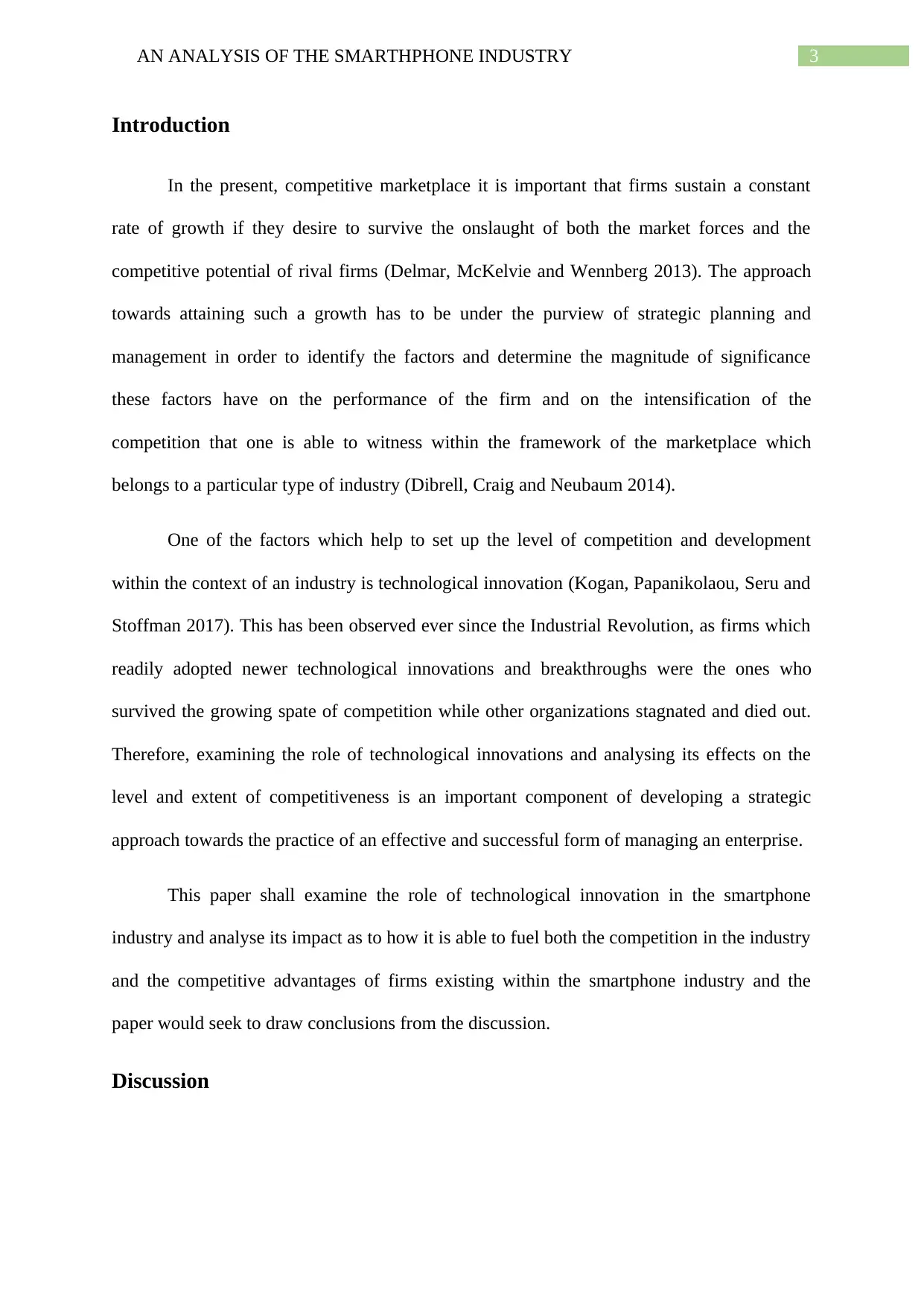
3AN ANALYSIS OF THE SMARTHPHONE INDUSTRY
Introduction
In the present, competitive marketplace it is important that firms sustain a constant
rate of growth if they desire to survive the onslaught of both the market forces and the
competitive potential of rival firms (Delmar, McKelvie and Wennberg 2013). The approach
towards attaining such a growth has to be under the purview of strategic planning and
management in order to identify the factors and determine the magnitude of significance
these factors have on the performance of the firm and on the intensification of the
competition that one is able to witness within the framework of the marketplace which
belongs to a particular type of industry (Dibrell, Craig and Neubaum 2014).
One of the factors which help to set up the level of competition and development
within the context of an industry is technological innovation (Kogan, Papanikolaou, Seru and
Stoffman 2017). This has been observed ever since the Industrial Revolution, as firms which
readily adopted newer technological innovations and breakthroughs were the ones who
survived the growing spate of competition while other organizations stagnated and died out.
Therefore, examining the role of technological innovations and analysing its effects on the
level and extent of competitiveness is an important component of developing a strategic
approach towards the practice of an effective and successful form of managing an enterprise.
This paper shall examine the role of technological innovation in the smartphone
industry and analyse its impact as to how it is able to fuel both the competition in the industry
and the competitive advantages of firms existing within the smartphone industry and the
paper would seek to draw conclusions from the discussion.
Discussion
Introduction
In the present, competitive marketplace it is important that firms sustain a constant
rate of growth if they desire to survive the onslaught of both the market forces and the
competitive potential of rival firms (Delmar, McKelvie and Wennberg 2013). The approach
towards attaining such a growth has to be under the purview of strategic planning and
management in order to identify the factors and determine the magnitude of significance
these factors have on the performance of the firm and on the intensification of the
competition that one is able to witness within the framework of the marketplace which
belongs to a particular type of industry (Dibrell, Craig and Neubaum 2014).
One of the factors which help to set up the level of competition and development
within the context of an industry is technological innovation (Kogan, Papanikolaou, Seru and
Stoffman 2017). This has been observed ever since the Industrial Revolution, as firms which
readily adopted newer technological innovations and breakthroughs were the ones who
survived the growing spate of competition while other organizations stagnated and died out.
Therefore, examining the role of technological innovations and analysing its effects on the
level and extent of competitiveness is an important component of developing a strategic
approach towards the practice of an effective and successful form of managing an enterprise.
This paper shall examine the role of technological innovation in the smartphone
industry and analyse its impact as to how it is able to fuel both the competition in the industry
and the competitive advantages of firms existing within the smartphone industry and the
paper would seek to draw conclusions from the discussion.
Discussion
Paraphrase This Document
Need a fresh take? Get an instant paraphrase of this document with our AI Paraphraser
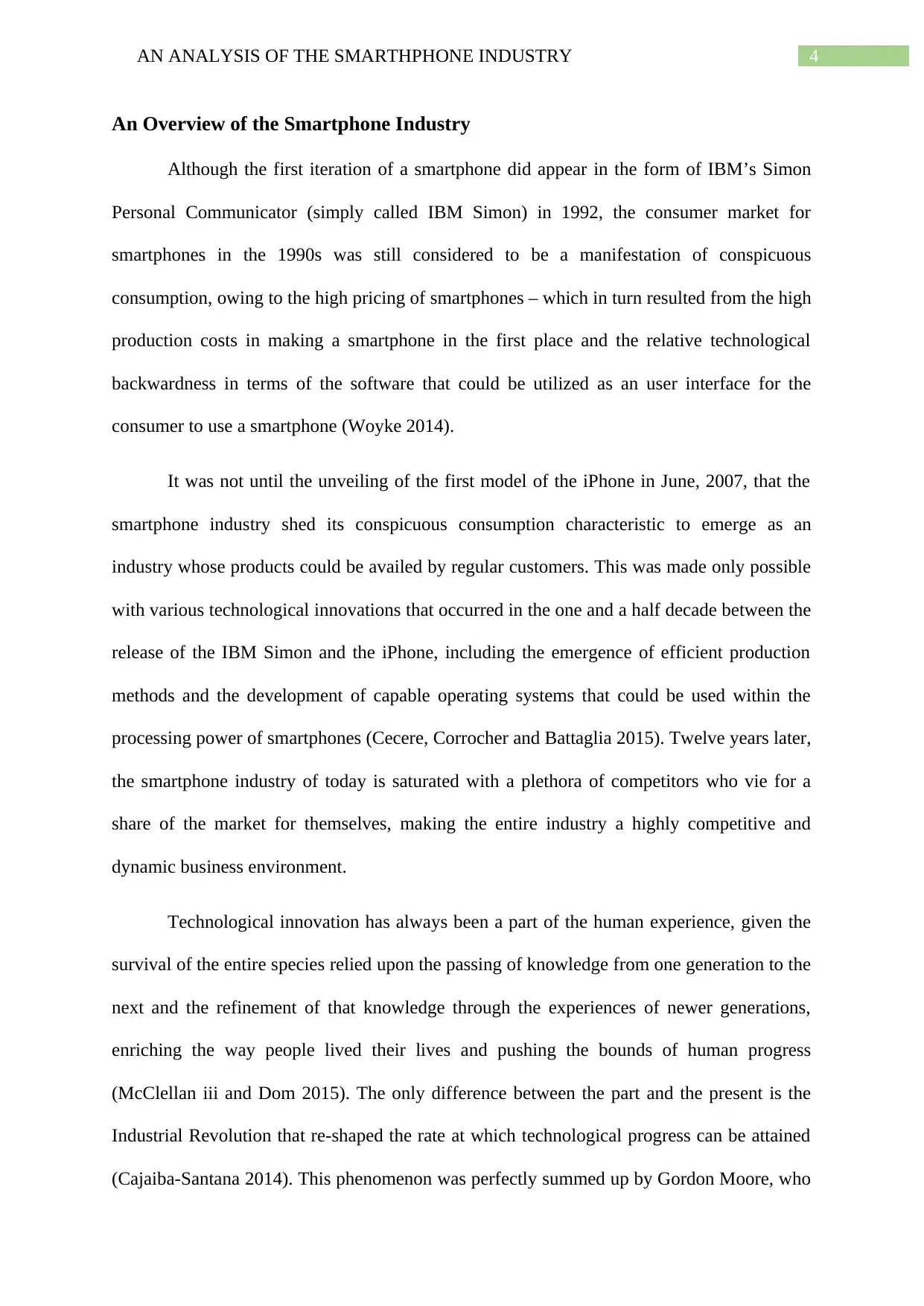
4AN ANALYSIS OF THE SMARTHPHONE INDUSTRY
An Overview of the Smartphone Industry
Although the first iteration of a smartphone did appear in the form of IBM’s Simon
Personal Communicator (simply called IBM Simon) in 1992, the consumer market for
smartphones in the 1990s was still considered to be a manifestation of conspicuous
consumption, owing to the high pricing of smartphones – which in turn resulted from the high
production costs in making a smartphone in the first place and the relative technological
backwardness in terms of the software that could be utilized as an user interface for the
consumer to use a smartphone (Woyke 2014).
It was not until the unveiling of the first model of the iPhone in June, 2007, that the
smartphone industry shed its conspicuous consumption characteristic to emerge as an
industry whose products could be availed by regular customers. This was made only possible
with various technological innovations that occurred in the one and a half decade between the
release of the IBM Simon and the iPhone, including the emergence of efficient production
methods and the development of capable operating systems that could be used within the
processing power of smartphones (Cecere, Corrocher and Battaglia 2015). Twelve years later,
the smartphone industry of today is saturated with a plethora of competitors who vie for a
share of the market for themselves, making the entire industry a highly competitive and
dynamic business environment.
Technological innovation has always been a part of the human experience, given the
survival of the entire species relied upon the passing of knowledge from one generation to the
next and the refinement of that knowledge through the experiences of newer generations,
enriching the way people lived their lives and pushing the bounds of human progress
(McClellan iii and Dom 2015). The only difference between the part and the present is the
Industrial Revolution that re-shaped the rate at which technological progress can be attained
(Cajaiba-Santana 2014). This phenomenon was perfectly summed up by Gordon Moore, who
An Overview of the Smartphone Industry
Although the first iteration of a smartphone did appear in the form of IBM’s Simon
Personal Communicator (simply called IBM Simon) in 1992, the consumer market for
smartphones in the 1990s was still considered to be a manifestation of conspicuous
consumption, owing to the high pricing of smartphones – which in turn resulted from the high
production costs in making a smartphone in the first place and the relative technological
backwardness in terms of the software that could be utilized as an user interface for the
consumer to use a smartphone (Woyke 2014).
It was not until the unveiling of the first model of the iPhone in June, 2007, that the
smartphone industry shed its conspicuous consumption characteristic to emerge as an
industry whose products could be availed by regular customers. This was made only possible
with various technological innovations that occurred in the one and a half decade between the
release of the IBM Simon and the iPhone, including the emergence of efficient production
methods and the development of capable operating systems that could be used within the
processing power of smartphones (Cecere, Corrocher and Battaglia 2015). Twelve years later,
the smartphone industry of today is saturated with a plethora of competitors who vie for a
share of the market for themselves, making the entire industry a highly competitive and
dynamic business environment.
Technological innovation has always been a part of the human experience, given the
survival of the entire species relied upon the passing of knowledge from one generation to the
next and the refinement of that knowledge through the experiences of newer generations,
enriching the way people lived their lives and pushing the bounds of human progress
(McClellan iii and Dom 2015). The only difference between the part and the present is the
Industrial Revolution that re-shaped the rate at which technological progress can be attained
(Cajaiba-Santana 2014). This phenomenon was perfectly summed up by Gordon Moore, who
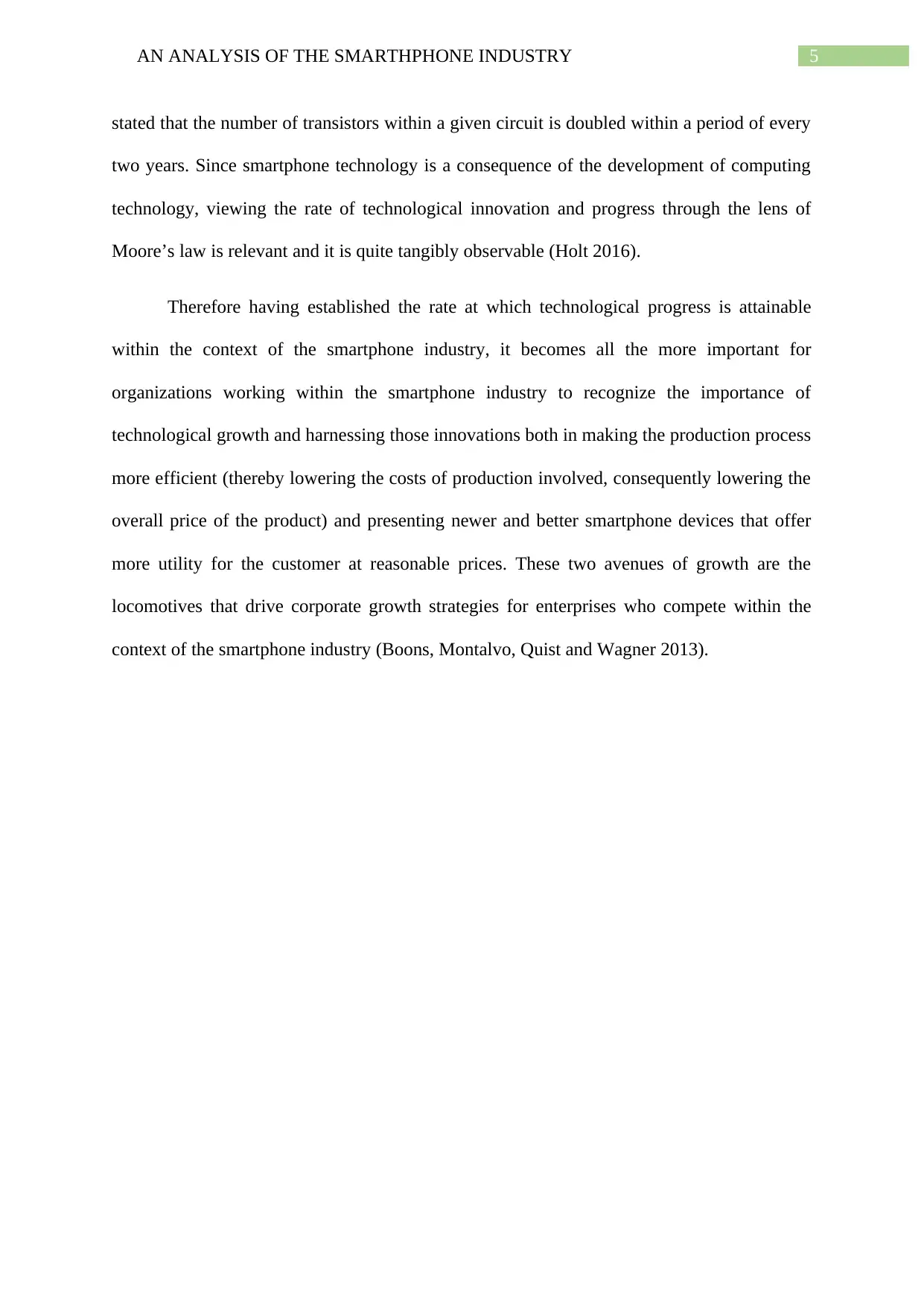
5AN ANALYSIS OF THE SMARTHPHONE INDUSTRY
stated that the number of transistors within a given circuit is doubled within a period of every
two years. Since smartphone technology is a consequence of the development of computing
technology, viewing the rate of technological innovation and progress through the lens of
Moore’s law is relevant and it is quite tangibly observable (Holt 2016).
Therefore having established the rate at which technological progress is attainable
within the context of the smartphone industry, it becomes all the more important for
organizations working within the smartphone industry to recognize the importance of
technological growth and harnessing those innovations both in making the production process
more efficient (thereby lowering the costs of production involved, consequently lowering the
overall price of the product) and presenting newer and better smartphone devices that offer
more utility for the customer at reasonable prices. These two avenues of growth are the
locomotives that drive corporate growth strategies for enterprises who compete within the
context of the smartphone industry (Boons, Montalvo, Quist and Wagner 2013).
stated that the number of transistors within a given circuit is doubled within a period of every
two years. Since smartphone technology is a consequence of the development of computing
technology, viewing the rate of technological innovation and progress through the lens of
Moore’s law is relevant and it is quite tangibly observable (Holt 2016).
Therefore having established the rate at which technological progress is attainable
within the context of the smartphone industry, it becomes all the more important for
organizations working within the smartphone industry to recognize the importance of
technological growth and harnessing those innovations both in making the production process
more efficient (thereby lowering the costs of production involved, consequently lowering the
overall price of the product) and presenting newer and better smartphone devices that offer
more utility for the customer at reasonable prices. These two avenues of growth are the
locomotives that drive corporate growth strategies for enterprises who compete within the
context of the smartphone industry (Boons, Montalvo, Quist and Wagner 2013).
⊘ This is a preview!⊘
Do you want full access?
Subscribe today to unlock all pages.

Trusted by 1+ million students worldwide
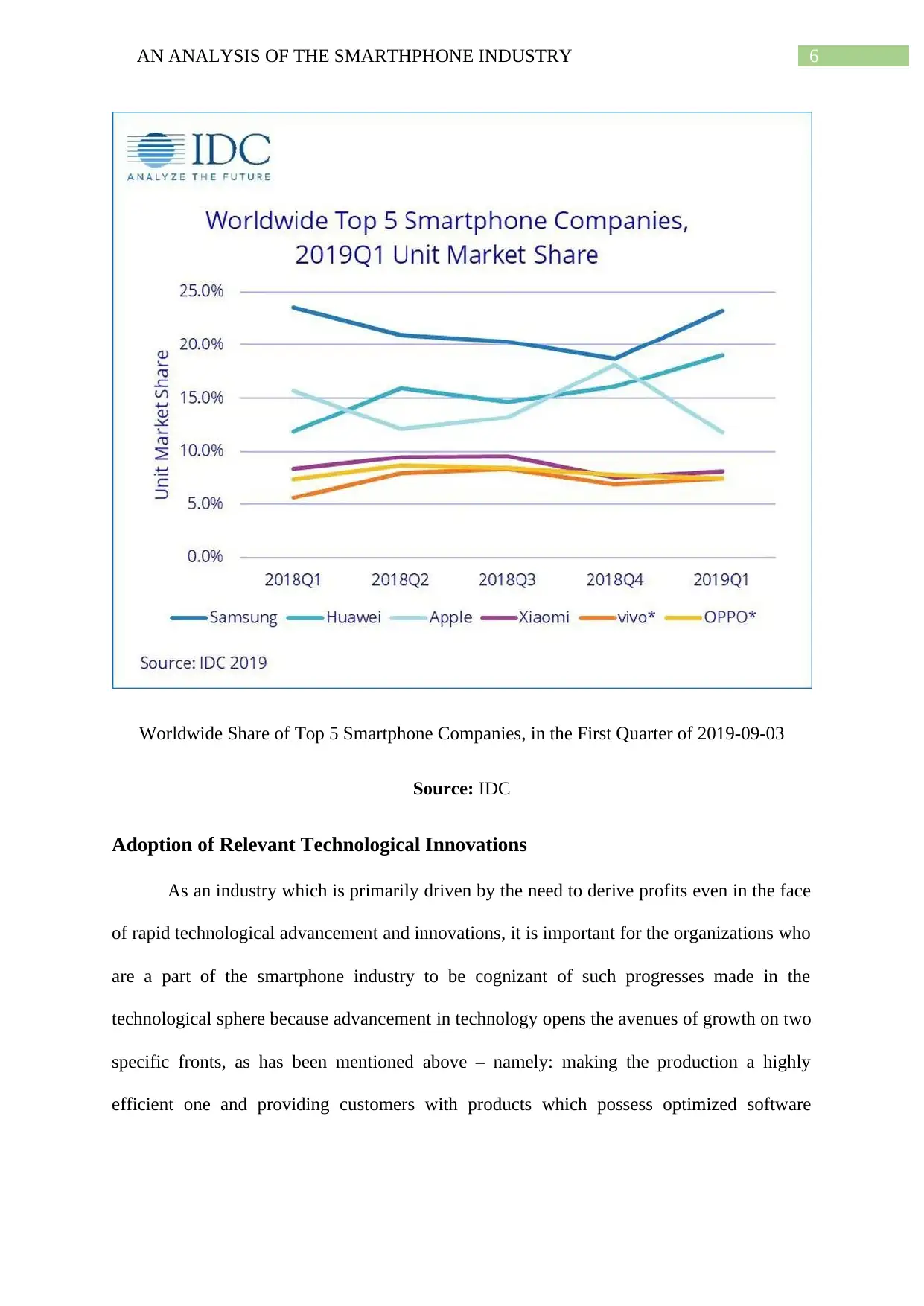
6AN ANALYSIS OF THE SMARTHPHONE INDUSTRY
Worldwide Share of Top 5 Smartphone Companies, in the First Quarter of 2019-09-03
Source: IDC
Adoption of Relevant Technological Innovations
As an industry which is primarily driven by the need to derive profits even in the face
of rapid technological advancement and innovations, it is important for the organizations who
are a part of the smartphone industry to be cognizant of such progresses made in the
technological sphere because advancement in technology opens the avenues of growth on two
specific fronts, as has been mentioned above – namely: making the production a highly
efficient one and providing customers with products which possess optimized software
Worldwide Share of Top 5 Smartphone Companies, in the First Quarter of 2019-09-03
Source: IDC
Adoption of Relevant Technological Innovations
As an industry which is primarily driven by the need to derive profits even in the face
of rapid technological advancement and innovations, it is important for the organizations who
are a part of the smartphone industry to be cognizant of such progresses made in the
technological sphere because advancement in technology opens the avenues of growth on two
specific fronts, as has been mentioned above – namely: making the production a highly
efficient one and providing customers with products which possess optimized software
Paraphrase This Document
Need a fresh take? Get an instant paraphrase of this document with our AI Paraphraser
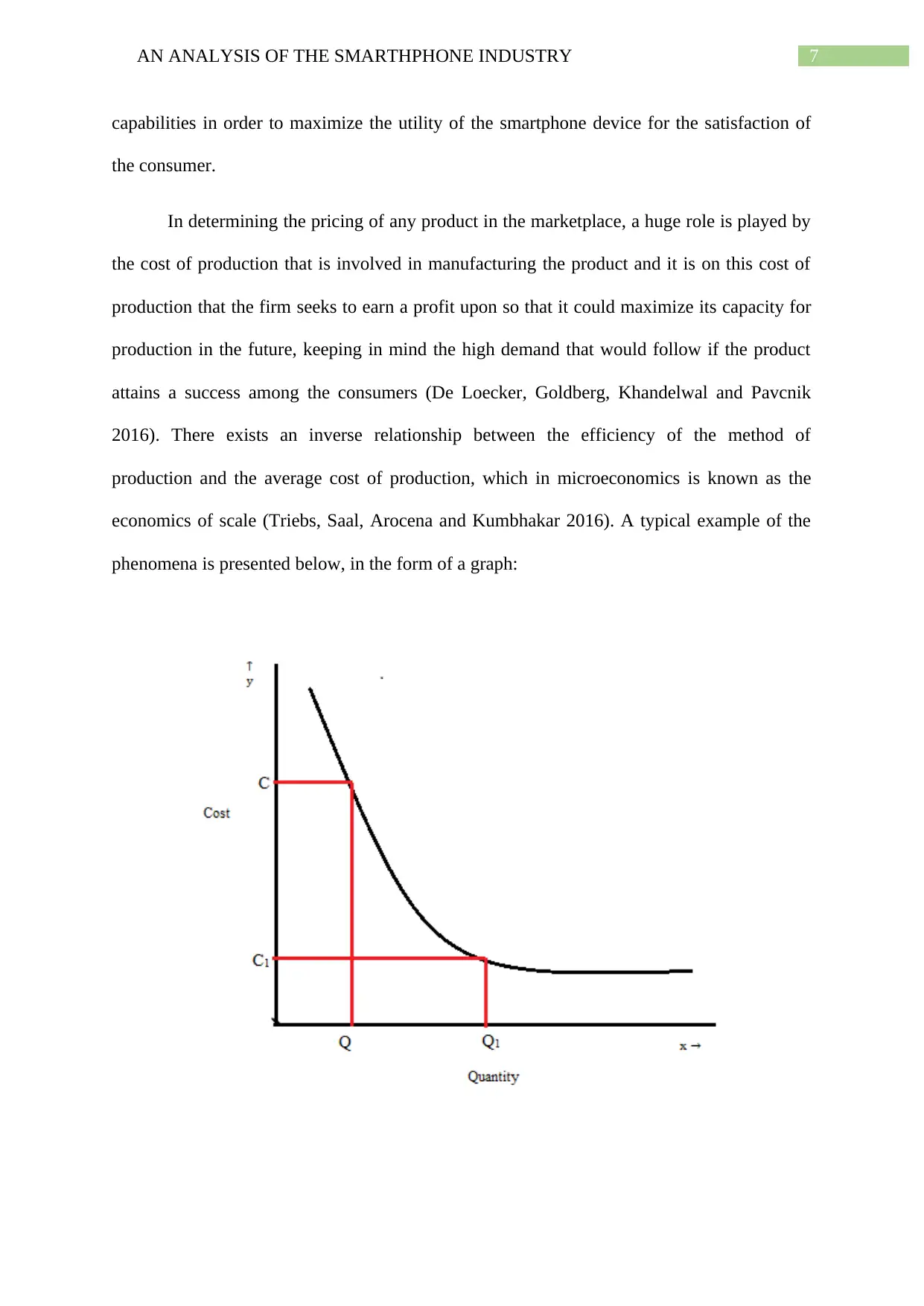
7AN ANALYSIS OF THE SMARTHPHONE INDUSTRY
capabilities in order to maximize the utility of the smartphone device for the satisfaction of
the consumer.
In determining the pricing of any product in the marketplace, a huge role is played by
the cost of production that is involved in manufacturing the product and it is on this cost of
production that the firm seeks to earn a profit upon so that it could maximize its capacity for
production in the future, keeping in mind the high demand that would follow if the product
attains a success among the consumers (De Loecker, Goldberg, Khandelwal and Pavcnik
2016). There exists an inverse relationship between the efficiency of the method of
production and the average cost of production, which in microeconomics is known as the
economics of scale (Triebs, Saal, Arocena and Kumbhakar 2016). A typical example of the
phenomena is presented below, in the form of a graph:
capabilities in order to maximize the utility of the smartphone device for the satisfaction of
the consumer.
In determining the pricing of any product in the marketplace, a huge role is played by
the cost of production that is involved in manufacturing the product and it is on this cost of
production that the firm seeks to earn a profit upon so that it could maximize its capacity for
production in the future, keeping in mind the high demand that would follow if the product
attains a success among the consumers (De Loecker, Goldberg, Khandelwal and Pavcnik
2016). There exists an inverse relationship between the efficiency of the method of
production and the average cost of production, which in microeconomics is known as the
economics of scale (Triebs, Saal, Arocena and Kumbhakar 2016). A typical example of the
phenomena is presented below, in the form of a graph:

8AN ANALYSIS OF THE SMARTHPHONE INDUSTRY
Source: Created by author
As can be seen in the graph presented above, the production cost of producing a
product falls with the increase in the efficiency of the production process, indicated by the
quantity in which that product is produced. With an increase of quantity of the product
produced from Q to Q1, the cost involved in the production of that product experiences a
decline from C to C1. This aspect within the framework of the economies of scale is known as
return to scale and attaining this return to scale is essential in pricing a product that is
affordable for the consumer while also meeting the demands of the market (Holtz-Eakin and
Lovely 2017).
Therefore, it is essential that firms competing within the smartphone industry are able
to adapt new technological advancements in their production methods in order to increase the
overall efficiency with which the devices are produced, reducing production costs and
maximizing profits for the enterprise thanks to increased demand. Hence, investment in the
research and development of advanced methods of production is a worthwhile investment
although it may take some time to translate itself into tangible results (Pisano 2015).
Another crucial area where technological innovation plays a key role within the
smartphone industry is the development and upgrading of software with which a smartphone
device is operatable by the consumer (Rusko 2014). Viewing through the lens of Moore’s
law, any firm in the industry has to necessarily upgrade its existing operating systems or to
introduce a completely newer version of its operating systems in order to stay relevant within
the competitive environment. Here too, research and development is a very crucial aspect that
is usually invested by the organization to maintain a competitive advantage within the
industry.
Source: Created by author
As can be seen in the graph presented above, the production cost of producing a
product falls with the increase in the efficiency of the production process, indicated by the
quantity in which that product is produced. With an increase of quantity of the product
produced from Q to Q1, the cost involved in the production of that product experiences a
decline from C to C1. This aspect within the framework of the economies of scale is known as
return to scale and attaining this return to scale is essential in pricing a product that is
affordable for the consumer while also meeting the demands of the market (Holtz-Eakin and
Lovely 2017).
Therefore, it is essential that firms competing within the smartphone industry are able
to adapt new technological advancements in their production methods in order to increase the
overall efficiency with which the devices are produced, reducing production costs and
maximizing profits for the enterprise thanks to increased demand. Hence, investment in the
research and development of advanced methods of production is a worthwhile investment
although it may take some time to translate itself into tangible results (Pisano 2015).
Another crucial area where technological innovation plays a key role within the
smartphone industry is the development and upgrading of software with which a smartphone
device is operatable by the consumer (Rusko 2014). Viewing through the lens of Moore’s
law, any firm in the industry has to necessarily upgrade its existing operating systems or to
introduce a completely newer version of its operating systems in order to stay relevant within
the competitive environment. Here too, research and development is a very crucial aspect that
is usually invested by the organization to maintain a competitive advantage within the
industry.
⊘ This is a preview!⊘
Do you want full access?
Subscribe today to unlock all pages.

Trusted by 1+ million students worldwide

9AN ANALYSIS OF THE SMARTHPHONE INDUSTRY
A Complication between R&D and Profits
Although research and development is the fundamental key towards harnessing
technological innovation by the various competitors within the smartphone industry, it is not
necessary for more investments within research and development to immediately materialize
itself into profits (Berchicci 2013). This is because by its very nature, investments into
research and development regarding adopting technological innovations both towards
streamlining the production process and updating the software with which the produced
devices operate are long-term in essence; therefore it is not always possible to expect tangible
profits in the short-run. Besides, there are a plethora of other conditions which causes such a
disparity between research and development, and profits.
Due to its long-term nature, the effects and consequences of investing in innovations
that could potentially cause the growth of the enterprise is purely speculative in nature
(Lazonick and Mezzucato 2013). A lot of variables are factored in while deciding if the
investment in research and development is a worthwhile venture and these various ventures
often involve their own dynamics, many of which often might be detrimental towards the
cause of innovating the various paths through which a firm may seek to grow and expand its
market share in the competitive arena of the smartphone industry.
Additionally, the long period of time that it takes for the firm to translate its
investments towards technological innovations, into an actual increase in sales makes it very
difficult for an economist or statistician to detect a statistically significant result in the
collected data (Löfsten 2014), thereby making it more of a difficult task to determine the
exact relationships that exists between developing new technological advances and using
them to achieve a competitive advantage, and the actual consequences of that competitive
advantage which is being sought after by the firm to cement its position within the
smartphone market and be ahead of its competitors.
A Complication between R&D and Profits
Although research and development is the fundamental key towards harnessing
technological innovation by the various competitors within the smartphone industry, it is not
necessary for more investments within research and development to immediately materialize
itself into profits (Berchicci 2013). This is because by its very nature, investments into
research and development regarding adopting technological innovations both towards
streamlining the production process and updating the software with which the produced
devices operate are long-term in essence; therefore it is not always possible to expect tangible
profits in the short-run. Besides, there are a plethora of other conditions which causes such a
disparity between research and development, and profits.
Due to its long-term nature, the effects and consequences of investing in innovations
that could potentially cause the growth of the enterprise is purely speculative in nature
(Lazonick and Mezzucato 2013). A lot of variables are factored in while deciding if the
investment in research and development is a worthwhile venture and these various ventures
often involve their own dynamics, many of which often might be detrimental towards the
cause of innovating the various paths through which a firm may seek to grow and expand its
market share in the competitive arena of the smartphone industry.
Additionally, the long period of time that it takes for the firm to translate its
investments towards technological innovations, into an actual increase in sales makes it very
difficult for an economist or statistician to detect a statistically significant result in the
collected data (Löfsten 2014), thereby making it more of a difficult task to determine the
exact relationships that exists between developing new technological advances and using
them to achieve a competitive advantage, and the actual consequences of that competitive
advantage which is being sought after by the firm to cement its position within the
smartphone market and be ahead of its competitors.
Paraphrase This Document
Need a fresh take? Get an instant paraphrase of this document with our AI Paraphraser
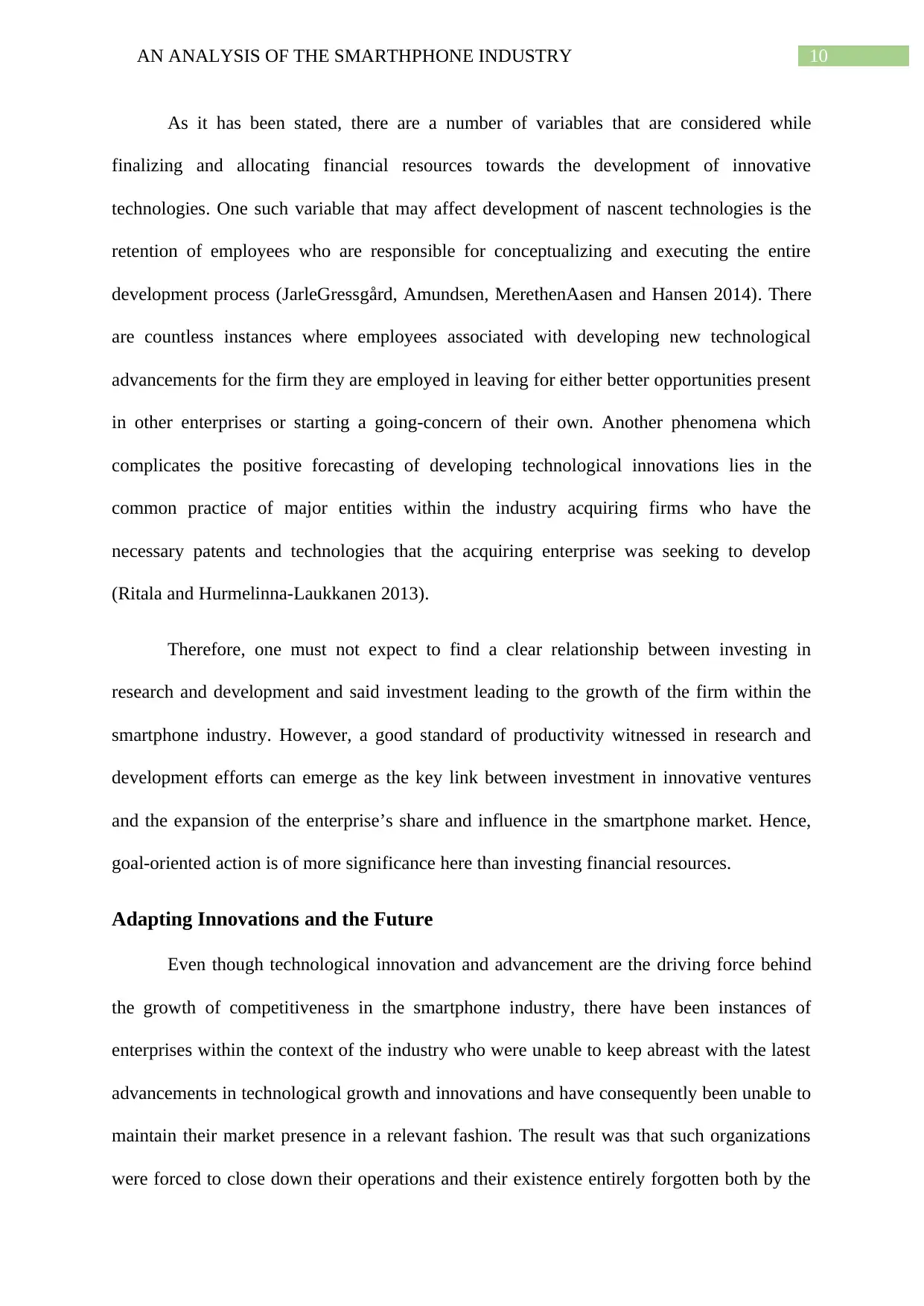
10AN ANALYSIS OF THE SMARTHPHONE INDUSTRY
As it has been stated, there are a number of variables that are considered while
finalizing and allocating financial resources towards the development of innovative
technologies. One such variable that may affect development of nascent technologies is the
retention of employees who are responsible for conceptualizing and executing the entire
development process (JarleGressgård, Amundsen, MerethenAasen and Hansen 2014). There
are countless instances where employees associated with developing new technological
advancements for the firm they are employed in leaving for either better opportunities present
in other enterprises or starting a going-concern of their own. Another phenomena which
complicates the positive forecasting of developing technological innovations lies in the
common practice of major entities within the industry acquiring firms who have the
necessary patents and technologies that the acquiring enterprise was seeking to develop
(Ritala and Hurmelinna‐Laukkanen 2013).
Therefore, one must not expect to find a clear relationship between investing in
research and development and said investment leading to the growth of the firm within the
smartphone industry. However, a good standard of productivity witnessed in research and
development efforts can emerge as the key link between investment in innovative ventures
and the expansion of the enterprise’s share and influence in the smartphone market. Hence,
goal-oriented action is of more significance here than investing financial resources.
Adapting Innovations and the Future
Even though technological innovation and advancement are the driving force behind
the growth of competitiveness in the smartphone industry, there have been instances of
enterprises within the context of the industry who were unable to keep abreast with the latest
advancements in technological growth and innovations and have consequently been unable to
maintain their market presence in a relevant fashion. The result was that such organizations
were forced to close down their operations and their existence entirely forgotten both by the
As it has been stated, there are a number of variables that are considered while
finalizing and allocating financial resources towards the development of innovative
technologies. One such variable that may affect development of nascent technologies is the
retention of employees who are responsible for conceptualizing and executing the entire
development process (JarleGressgård, Amundsen, MerethenAasen and Hansen 2014). There
are countless instances where employees associated with developing new technological
advancements for the firm they are employed in leaving for either better opportunities present
in other enterprises or starting a going-concern of their own. Another phenomena which
complicates the positive forecasting of developing technological innovations lies in the
common practice of major entities within the industry acquiring firms who have the
necessary patents and technologies that the acquiring enterprise was seeking to develop
(Ritala and Hurmelinna‐Laukkanen 2013).
Therefore, one must not expect to find a clear relationship between investing in
research and development and said investment leading to the growth of the firm within the
smartphone industry. However, a good standard of productivity witnessed in research and
development efforts can emerge as the key link between investment in innovative ventures
and the expansion of the enterprise’s share and influence in the smartphone market. Hence,
goal-oriented action is of more significance here than investing financial resources.
Adapting Innovations and the Future
Even though technological innovation and advancement are the driving force behind
the growth of competitiveness in the smartphone industry, there have been instances of
enterprises within the context of the industry who were unable to keep abreast with the latest
advancements in technological growth and innovations and have consequently been unable to
maintain their market presence in a relevant fashion. The result was that such organizations
were forced to close down their operations and their existence entirely forgotten both by the

11AN ANALYSIS OF THE SMARTHPHONE INDUSTRY
industry and the consumers who utilize the smartphone. Hence, adopting new technological
innovations is an imperative method of staying afloat amidst the competition. An example
which demonstrates this to a degree is Nokia’s history in the period between 2005 and 2010;
by this time Nokia was utilizing the Symbian operating system for its mobile devices and it
held a prestigious share in the mobile device market. However, the emergence of Apple’s iOS
and Google’s Android operating systems posed a serious threat as it increasingly made the
Symbian OS an outdated technological platform. In order to prevent being pushed out of the
market and compete with Apple and Android devices, Nokia decided to strike up a strategic
partnership with Microsoft to create smartphone devices which would use the Windows
Mobile operating system. This not only saved Nokia from becoming relegated in its market
share, but it also helped to find new customers and helped them to emerge as viable
competitors to iOS and Android devices.
This happens partly because of the rapid rate at which such technological
breakthrough occurs, which renders the management of an organization almost incapable of
promptly responding to such changes in a comprehensive and efficient manner, and partly
because the management of the firm might feel uncomfortable or unsure about investing in
innovations whose outcomes would not be immediately discernable. Hence, both of these
factors are major reasons as to why certain firms are unable to embrace the notion of adapting
technological innovations and then converting them into long-term assets. Therefore, while
some firms may accept the need to integrate new technological advancements as a means to
enlarge the operations of their firms, other enterprises may not be too enthusiastic about
doing so and are hence sidelined from the immensely competitive environment of the
smartphone industry.
Technological advancement and innovation has always been a part of the human
experience, where the need for survival propelled people to develop and refine their
industry and the consumers who utilize the smartphone. Hence, adopting new technological
innovations is an imperative method of staying afloat amidst the competition. An example
which demonstrates this to a degree is Nokia’s history in the period between 2005 and 2010;
by this time Nokia was utilizing the Symbian operating system for its mobile devices and it
held a prestigious share in the mobile device market. However, the emergence of Apple’s iOS
and Google’s Android operating systems posed a serious threat as it increasingly made the
Symbian OS an outdated technological platform. In order to prevent being pushed out of the
market and compete with Apple and Android devices, Nokia decided to strike up a strategic
partnership with Microsoft to create smartphone devices which would use the Windows
Mobile operating system. This not only saved Nokia from becoming relegated in its market
share, but it also helped to find new customers and helped them to emerge as viable
competitors to iOS and Android devices.
This happens partly because of the rapid rate at which such technological
breakthrough occurs, which renders the management of an organization almost incapable of
promptly responding to such changes in a comprehensive and efficient manner, and partly
because the management of the firm might feel uncomfortable or unsure about investing in
innovations whose outcomes would not be immediately discernable. Hence, both of these
factors are major reasons as to why certain firms are unable to embrace the notion of adapting
technological innovations and then converting them into long-term assets. Therefore, while
some firms may accept the need to integrate new technological advancements as a means to
enlarge the operations of their firms, other enterprises may not be too enthusiastic about
doing so and are hence sidelined from the immensely competitive environment of the
smartphone industry.
Technological advancement and innovation has always been a part of the human
experience, where the need for survival propelled people to develop and refine their
⊘ This is a preview!⊘
Do you want full access?
Subscribe today to unlock all pages.

Trusted by 1+ million students worldwide
1 out of 17
Related Documents
Your All-in-One AI-Powered Toolkit for Academic Success.
+13062052269
info@desklib.com
Available 24*7 on WhatsApp / Email
![[object Object]](/_next/static/media/star-bottom.7253800d.svg)
Unlock your academic potential
Copyright © 2020–2025 A2Z Services. All Rights Reserved. Developed and managed by ZUCOL.





